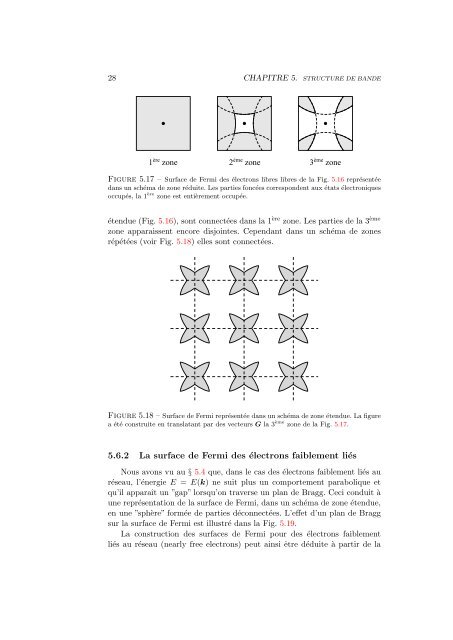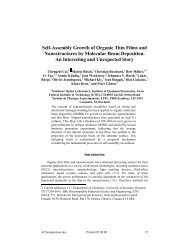Les électrons dans un potentiel périodique. Structure de bande - EPFL
Les électrons dans un potentiel périodique. Structure de bande - EPFL
Les électrons dans un potentiel périodique. Structure de bande - EPFL
You also want an ePaper? Increase the reach of your titles
YUMPU automatically turns print PDFs into web optimized ePapers that Google loves.
28 CHAPITRE 5. STRUCTURE DE BANDE<br />
1 ère zone 2 ème zone 3 ème zone<br />
Figure 5.17 – Surface <strong>de</strong> Fermi <strong>de</strong>s <strong>électrons</strong> libres libres <strong>de</strong> la Fig. 5.16 représentée<br />
<strong>dans</strong> <strong>un</strong> schéma <strong>de</strong> zone réduite. <strong>Les</strong> parties foncées correspon<strong>de</strong>nt aux états électroniques<br />
occupés, la 1 ère zone est entièrement occupée.<br />
étendue (Fig. 5.16), sont connectées <strong>dans</strong> la 1 ère zone. <strong>Les</strong> parties <strong>de</strong> la 3 ème<br />
zone apparaissent encore disjointes. Cependant <strong>dans</strong> <strong>un</strong> schéma <strong>de</strong> zones<br />
répétées (voir Fig. 5.18) elles sont connectées.<br />
Figure 5.18 – Surface <strong>de</strong> Fermi représentée <strong>dans</strong> <strong>un</strong> schéma <strong>de</strong> zone étendue. La figure<br />
a été construite en translatant par <strong>de</strong>s vecteurs G la 3 ème zone <strong>de</strong> la Fig. 5.17.<br />
5.6.2 La surface <strong>de</strong> Fermi <strong>de</strong>s <strong>électrons</strong> faiblement liés<br />
Nous avons vu au § 5.4 que, <strong>dans</strong> le cas <strong>de</strong>s <strong>électrons</strong> faiblement liés au<br />
réseau, l’énergie E = E(k) ne suit plus <strong>un</strong> comportement parabolique et<br />
qu’il apparaît <strong>un</strong> ”gap” lorsqu’on traverse <strong>un</strong> plan <strong>de</strong> Bragg. Ceci conduit à<br />
<strong>un</strong>e représentation <strong>de</strong> la surface <strong>de</strong> Fermi, <strong>dans</strong> <strong>un</strong> schéma <strong>de</strong> zone étendue,<br />
en <strong>un</strong>e ”sphère” formée <strong>de</strong> parties déconnectées. L’effet d’<strong>un</strong> plan <strong>de</strong> Bragg<br />
sur la surface <strong>de</strong> Fermi est illustré <strong>dans</strong> la Fig. 5.19.<br />
La construction <strong>de</strong>s surfaces <strong>de</strong> Fermi pour <strong>de</strong>s <strong>électrons</strong> faiblement<br />
liés au réseau (nearly free electrons) peut ainsi être déduite à partir <strong>de</strong> la



